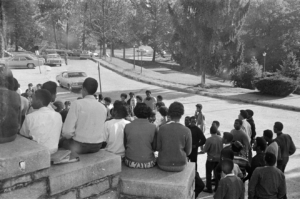We know how to fix the problem of gun violence, so why haven’t we acted on it?
This viewpoint originally appeared in BU Today.
On May 24, a gunman walked into Robb Elementary School in Uvalde, Tex., and killed 19 children and 2 teachers. It was the third deadliest school shooting in US history. It recalls the shooting 10 years ago, when 20 students and 6 adults were killed by a gunman at Sandy Hook Elementary School. More recently, at a high school in Parkland, Fla, a shooter killed 17 people. While these are the most visible school shootings over the past decade, 27 other school shootings have taken place this year alone and over 200 mass shootings—defined as when 4 or more people are shot or killed—have happened this year as well. There were 693 mass shootings in 2021. Horrifically, two weeks ago we saw guns used in a racially motivated massacre in Buffalo, N.Y., where 13 people were shot and 10 killed, with 11 of the victims Black. The list could, and does, go on.
Although mass shootings galvanize our attention when they occur, they account for just 1 to 2 percent of all gun-related deaths. Gun deaths have continued to rise most years since 2014. In 2021, over 21,000 people died from gun violence, excluding suicides. In 2021, 22 people were killed in school shooting incidents; worth noting, at least 51 transgender or gender nonconforming people were killed by guns that year. The gun violence crisis is also inextricable from the challenge of suicide. The rate of gun violence suicide in the United States is 7.1 per 100,000 people—6 out of 10 gun deaths in the United States are suicides, with about 65 gun violence suicides each day.
Then there are those who are shot by guns who do not die, but must live with the physical and mental consequences of their injury. Work by our research team and others estimates that for every person killed by gun violence, another two people are injured and survive, with many living with the devastating consequences of gun injury. On top of physical injuries are the mental health consequences of gun violence, both among those who are shot and among their communities. The mental health effects of exposure to violence can include depression, post-traumatic stress disorder, and anxiety.
Gun violence, then, is clearly a problem. To paraphrase former Surgeon General David Satcher, the School of Public Health 2020 convocation speaker, if gun violence were not a public health problem, why are so many people dying from it? The persistence of the problem might suggest that we do not actually know how to fix it. But we do know how. Potential solutions were well-summarized recently by David Hogg and John Rosenthal in the Boston Globe. These solutions include banning military-style assault weapons and large-capacity ammunition magazines, enacting universal background check regulation, and better regulating the firearm industry.
Importantly, we know that action on these measures makes a difference. Massachusetts, for example, has long had near the lowest rate of gun violence in the United States. This success is built on a foundation of commonsense gun safety reform, including better regulation of the gun industry, bans on military-style assault weapons and high-capacity magazines, and universal safe storage laws for firearms. If embraced by the nation, the Massachusetts model could serve as a blueprint for how we might address this problem as a country.
One might also think that given the devastation wrought by gun violence and our clear understanding of what can prevent it, we would act on this problem, as we have acted on other problems of consequence for public health. But we do not. It is not because we do not all recognize that this is a problem—prominent Americans of all political stripes acknowledge the devastation of gun violence. Texas Governor Greg Abbott called the recent shooting a “horrific loss,” Texas’ US Senator Ted Cruz said, “We’ve seen too many of these shootings,” former President Barack Obama said, “It’s long past time for action,” and President Joe Biden echoed this, saying, “It’s time to turn this pain into action.” Why, then, have we not acted?
I have come to think that our inaction on this problem stems from our failure to balance the moral and the empiric argument for a healthier world. I have written previously that action will only happen if we strike this balance. In 2016, we convened schools and programs of public health to articulate what should be done about this problem, creating an agenda for action for academic public health’s engagement with this issue. While there has been action on some of that agenda, notably with more research funding, much remains to be done. But centrally, what that agenda suggests is the need for a confluence of evidence for action and will to act. And that is where the country continually fails.
So, how to act? Action requires calls to address gun violence whenever it occurs, again and again, in defiance of the numbness we may be tempted to feel. We must remember that each shooting is horrific, and they all remain preventable. That a world where we reckon with guns, where what is now acceptable becomes unacceptable, is a better world. Action also requires the generation of ever-more data to turn the tide of the gun violence debate. And the tide will turn. But bending the moral arc on this issue will take persistent pressure. In the meantime, shootings will sadly, devastatingly, continue to happen. When they do, we will grieve, rage, perhaps despair.
And then we will keep working.
Sandro Galea is the Robert A. Knox Professor and dean of the BU School of Public Health.




